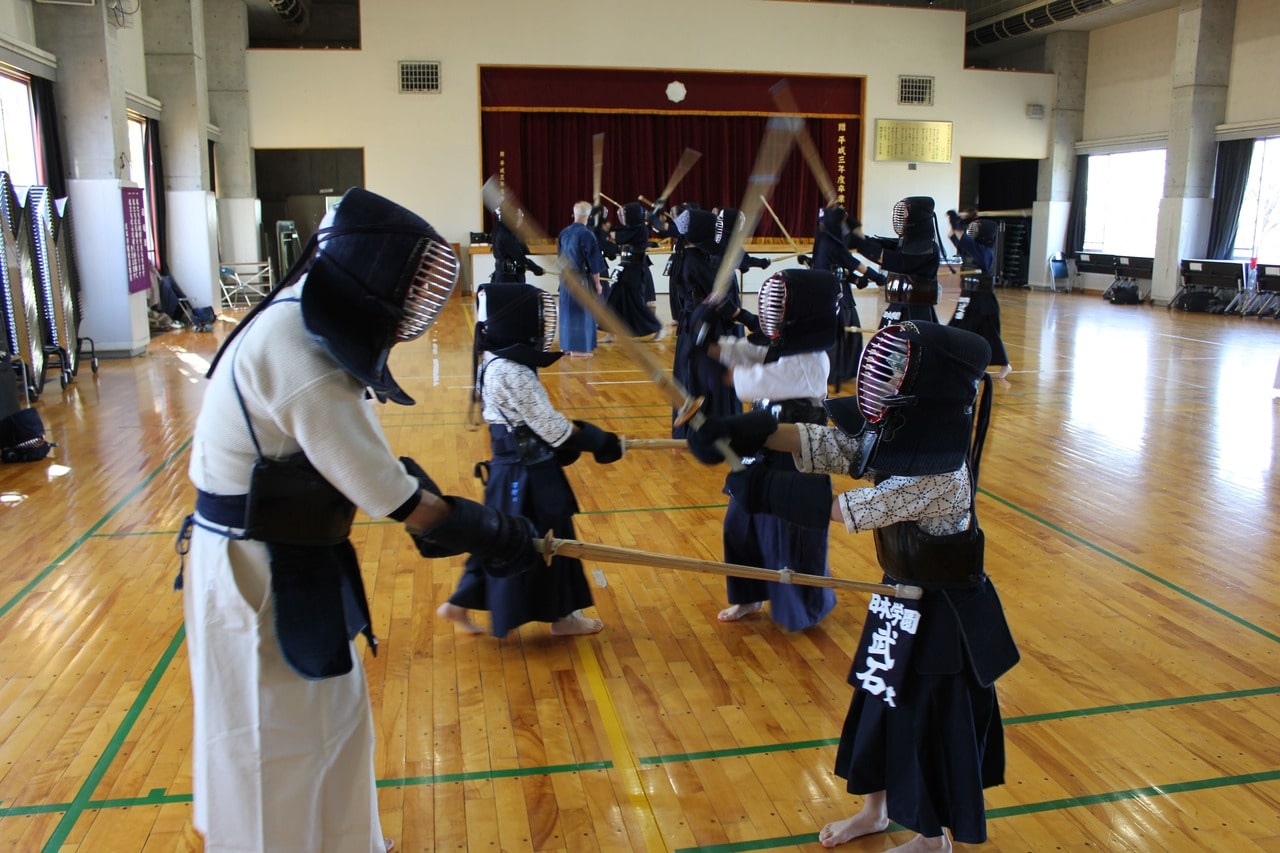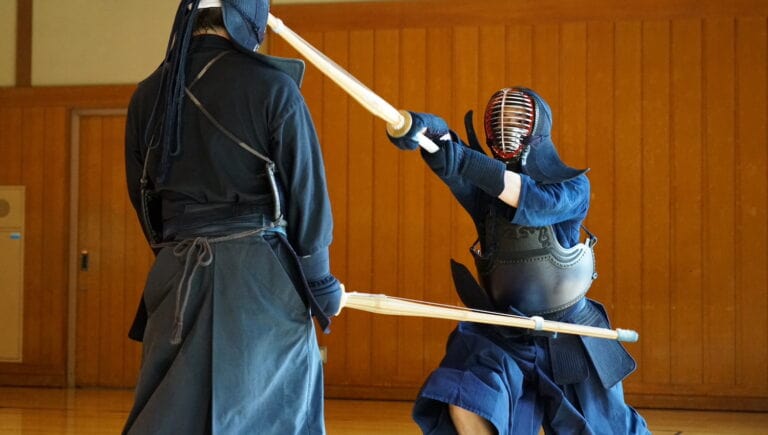
Shinai is an essential tool in Kendo, and learning how to properly assemble it is also important for improving Kendo techniques.
In this article, we will explain in detail the correct way to assemble a shinai and the role of each part.
From beginners to experts, you’ll learn how to assemble Shinai safely and efficiently, as well as learn how to properly maintain them.
This guide aims to help you hone your Kendo techniques and lead to better practice.
目次
- 1 Basic knowledge of assembling bamboo swords
- 2 How to disassemble a bamboo sword
- 3 Instructions for assembling a bamboo sword
- 4 Attaching and adjusting the tip leather
- 5 How to tie a middle knot
- 6 How to attach and fix the handle
- 7 Maintenance and storage of Shinai
- 8 FAQ: Common questions about Shinai sword assembly
Basic knowledge of assembling bamboo swords
In Kendo, the Shinai is not just a tool; it is an important element that makes a difference in technique depending on how you use it.
Correct assembly will ensure safe and effective practice.
Parts and roles of Shinai
Shinai is made up of multiple parts, each serving a specific function:
- Bamboo body : The main part of the bamboo sword, made of bamboo. This is the main part of striking, and requires appropriate elasticity and strength.
- Handle : This is the part where you grip the bamboo sword, and the fit and operability of your hand are important. Usually covered with leather or cloth.
- Tsuba : Attached between the handle and the bamboo blade, it serves to protect the hand. Protects your hands from impact during Kendo movements.
- Tsubadome : A small part that fixes the tsuba so that it does not shift. In order to practice safely, you need to wear them securely.
By properly combining these parts, a functional and well-balanced shinai is completed.
How to choose a bamboo sword and precautions
When choosing a bamboo sword, please note the following:
- Length and weight : It is important to choose a Shinai that matches the user’s height and muscle strength. Generally speaking, the length should be around the waist, but it may be adjusted depending on your preference and training style.
- Material : There are various types of materials for Shinai, and each type of bamboo has different elasticity and durability. It is important to choose according to the frequency of use and purpose.
- Balance : The balance of a Shinai is directly related to its ease of handling. It is important to feel the balance so that the hand is not too heavy and the tip is not too light.
Choosing the right shinai will not only improve your technique, but will also help prevent injuries.
We recommend that you consult with a specialized store and try it out in person before purchasing.

How to disassemble a bamboo sword
Proper disassembly and maintenance of Shinai is very important to maintain its performance and prolong its life.
Learn the correct disassembly method and be able to perform maintenance yourself.
Necessary tools and preparations
Before disassembling the Shinai, please prepare the following tools:
- Small mallet or rubber hammer : Used to remove the tsuba.
- Vinyl gloves : non-slip and provide a better grip.
- Shinai screwdriver : Used to loosen the fixing screw on the handle.
- Water : If the handle is hard and difficult to remove, use it to wet the handle and expand it.
By using these tools, you can safely and reliably remove the parts of the shinai.
Step-by-step disassembly
The steps to disassemble the bamboo sword are as follows:
- Removing the collar stopper : First, loosen the collar stopper. If this doesn’t come loose, try wearing vinyl gloves for a better grip or use a mallet to tap it gently.
- Removing the tsuba : Once the tsuba stop is removed, gently slide the tsuba to remove it.
- Removing the handle : After removing the tsuba, slowly pull out the handle. If the handle is still hard, dampen it with water, wait a bit, and try again.
- Unstringing : After removing the handle, untie the string at the tip of the shinai.
- Cleaning the inside : Once the inside of the shinai is exposed, clean the dust and dirt. It is important to dry all parts after cleaning.
Following these steps to properly disassemble your Shinai will prevent damage to its parts and allow for effective maintenance.
Disassembly is also a good opportunity to check the condition of your shinai and replace parts if necessary.

Instructions for assembling a bamboo sword
Assembling a bamboo sword is one of the basic skills that supports Kendo techniques.
Learning how to properly assemble the shinai is essential to getting the most out of your shinai performance and practicing safely.
How to attach patterned leather
The attachment of the handle directly affects the comfortable grip and maneuverability of the Shinai. Below are the instructions for installing patterned leather:
- Preparing the patterned leather : Prepare a new patterned leather and adjust the size to match the length of the pattern. If the handle leather is hard, soak it in water a little to soften it and make it easier to attach.
- Start wrapping the handle leather : Start from the base of the handle and roll the leather evenly. At this time, be careful to overlap the ends of the leather evenly and press firmly to prevent air from entering.
- Treatment of the ends : The ends of the patterned leather are secured with special glue or with appropriate stitching.
How to tie and adjust strings
The way the string is tied and its adjustment is particularly important as it affects the balance and functionality of the Shinai:
- Preparing the string : Prepare a new string and cut it to match the length of the shinai.
- How to thread the string : Thread the string through the hole of the Shinai and tie a knot while pulling it evenly. At this time, make sure that the strings are tensioned evenly.
- Adjusting the knot : Adjust the string to have the proper tension. When the string is properly tensioned, the Shinai will be firmly fixed and will not move.
- Final check : Make sure the strings are evenly tensioned and the knots are securely secured, making minor adjustments as necessary.
By following these steps properly, your Shinai will perform consistently and you will get the best results in your Kendo training and competitions.
It may take some time at first, but if you do it repeatedly, you will be able to assemble the Shinai smoothly.

Attaching and adjusting the tip leather
The shinai tip leather is an important part that protects the tip of the shinai and cushions the impact of blows.
Choosing and attaching the correct tip leather is essential for maximizing the performance of the shinai and practicing safely.
How to choose tip leather
Here are some points to keep in mind when choosing a foreleather:
- Material : There are various materials for the tip leather, such as cowhide and synthetic leather. Cowhide leather is highly durable, while synthetic leather is lightweight and flexible. Choose according to your frequency of use and personal preference.
- Thickness and flexibility : Thick toe leather is more durable and absorbs the impact of blows better, but it tends to be heavier. Thin tip leather is lighter and easier to handle, but has poor shock absorption. In addition, the highly flexible tip leather makes it easy to fit the shape, making it comfortable to use from the beginning.
- Size : It is important to choose a tip leather that matches the size of your shinai. If the size is incorrect, it will not be possible to install it correctly, which will cause performance to deteriorate.
Installing in the correct position
The steps to attach the tip leather to the bamboo sword are as follows:
- Preparing the tip leather : When using new tip leather, it is important to shape it first. New leather can be hard, so it’s best to rub it with your hands until it becomes soft.
- Fixing the tip leather to the shinai : Align the bottom of the tip leather with the tip of the shinai, and fold the edge of the leather evenly along the shinai.
- Secure with a string : Wrap the string around the foreleather and tie it tightly. At this time, it is important to tension the strings evenly. If the string is tensioned evenly, the tip leather will be firmly fixed to the shinai and will be difficult to move.
- Make adjustments : Make sure that the tip leather is fixed in the correct position and make minor adjustments as necessary. Adjust the strings accordingly to prevent the tip from shifting.
By following these steps carefully, the shinai tip leather will be securely fixed in the proper position, allowing you to get the most out of your shinai.
By mastering the correct method of attachment, you can extend the life of your Shinai and enable safe and effective practice.

How to tie a middle knot
The nakamusubi is an important part of the shinai and is essential for keeping the components of the shinai firmly in place and safe during use.
By tying the Nakamusubi correctly, you can expect that the performance of the Shinai will improve and it will last a long time.
Function of middle knot
The Nakamusubi holds each part of the Shinai in its proper position and maintains its overall strength. Main features include:
- Fixing parts : Make sure that the handle, tip leather, string, etc. of the bamboo sword are fixed in the correct position without shifting.
- Shock Absorption : Absorbs the impact when struck and prevents the Shinai from being damaged.
- Improved ease of use : A properly tied knot improves ease of holding and use.
Correct way to tie a middle knot
Accuracy is required when tying a Nakaknot. Here are some basic tying techniques:
- Preparing the string : Prepare the string to be used for the center knot and cut it to the appropriate length.
- Start tying : Place the string in the center of the shinai and secure one end. This will be the starting point for the knot.
- Cross-knot : Wrap the string around the shinai multiple times and cross the string at the end of each wrap to increase its strength.
- Tighten : Tighten the strings firmly while pulling them evenly. At this time, make sure that the strings are tensioned evenly.
- Fixing : Tie off the end of the string and cut off or hide the excess.
By tying the shinai according to this procedure, you can use the shinai stably and keep it in good condition for a long time.
Although Nakamusubi looks simple, it greatly affects the performance of the Shinai, so it is important to do it carefully.

How to attach and fix the handle
In Kendo Shinai, the correct attachment and fixation of the handle directly affects maneuverability and performance.
Knowing everything from selecting the appropriate handle to how to properly secure the handle is important for practicing Kendo safely and effectively.
Types and characteristics of patterns
There are many different types of handles, each with different characteristics depending on the material, shape, and length:
- Material : The handle is generally made of wood, which provides the shinai with comfort and grip stability. The use of high quality wood increases durability.
- Shape : The handle comes in several shapes with different diameters. It is important to choose one according to the size of the user’s hands. Some handles may also have fine grooves to prevent slipping.
- Surface treatment : The surface of the handle is often treated to prevent slipping. Some of these are made from shark skin or synthetic materials.
How to securely fix the handle
To securely secure the handle to the bamboo sword, follow these steps:
- Preparing the handle : Make sure the handle is the right size for the bamboo blade of the shinai. The inner diameter of the handle and the outer diameter of the bamboo must match perfectly.
- Attaching the handle : Gently push the handle into the bamboo from the end. At this time, be careful not to bend the handle by applying even pressure.
- Using the handle string : After the handle is completely inserted into the bamboo, use the handle string to secure the handle. Wrap the handle string around the base of the handle and tie it tightly to prevent the handle from moving.
- Final check : Make sure the handle is firmly fixed. If the handle is not securely secured, retighten the handle strap or adjust the handle position as necessary.
By following these steps carefully, you will ensure that the handle is securely attached to the Shinai, preventing it from shifting or causing discomfort during use.
By attaching the handle correctly, you will improve your Kendo techniques and be able to practice more comfortably.

Maintenance and storage of Shinai
Proper maintenance and storage of your Shinai is essential to extend its lifespan and ensure that it is always in top condition.
Here, we will explain in detail how to clean and maintain your Shinai, as well as how to store it to make it last longer.
Cleaning and maintenance of Shinai
Regular cleaning and inspection are important for maintaining a Shinai. Here are the basic steps:
- Cleaning : After using the Shinai, wipe off sweat and dirt with a cloth. It is especially important to dry metal parts thoroughly to prevent rust.
- Inspection : Regularly check each part of the shinai to make sure it is not loose or damaged. In particular, check that the handle string and guard stopper are not loose, and that the bamboo is not cracked.
- Adjustment : Replace or adjust parts as necessary. If the bamboo blade is bent, it can be corrected by adjusting the humidity.
How to store it for a long time
How to store your Shinai to make it last longer is just as important as maintenance. Here are some tips for proper storage:
- Appropriate location : Store the shinai in a place away from direct sunlight, high temperature and humidity. A place with good ventilation is recommended as a humid place will have a negative effect on the Shinai.
- Storage position : It is more ideal to store the Shinai lying on its side than to store it upright. This prevents the bamboo from bending due to gravity.
- Protective measures : It is a good idea to insert a sachet of silica gel into the handle of the shinai to absorb moisture. It is also effective to use a special Shinai bag to protect it from dust and dirt.
By properly maintaining and storing these methods, you can keep your Shinai in the best condition for a long time and improve your performance during Kendo practice and matches.

FAQ: Common questions about Shinai sword assembly
Assembling a bamboo sword can be a difficult task, especially for beginners.
This section describes common problems and their solutions during assembly.
This information will help you assemble the shinai smoothly.
Common problems and solutions during assembly
-
Problem: The handle is stiff and cannot be inserted.
- Solution : If the handle is stiff, spray a little water on the handle and wait for the wood to expand. You can also use a hammer to tap it lightly to make it easier to insert the handle. However, be careful not to use too much force.
-
Problem: Tsuba does not fit properly
- Solution : If the collar does not fit properly, please adjust the position of the collar stopper. If the collar is loose, you need to tighten it firmly. If the clasp is hard, applying a little oil will make it slippery.
-
Problem: Strings are difficult to tie
- Solution : If the string is difficult to tie, dampen the string before tying it to make it more flexible and easier to handle. It is also convenient to use tweezers or a special tying tool when tying the strings.
-
Problem: The whole bamboo sword is shaky.
- Solution : If the shinai is wobbly, check that all parts are assembled correctly. In particular, check that the handle string and inner knot are not loose, and retie or adjust them as necessary.
-
Problem: The bamboo sword is unbalanced.
- Solution : If the balance is poor, you may need to readjust the placement of the bamboo sword parts. Of particular importance is the position of the tsuba and handle. If these are not in the proper position, the balance will be poor.
Understanding and applying solutions to these common problems will make assembling a shinai easier and more efficient.
Always work carefully and accurately.






